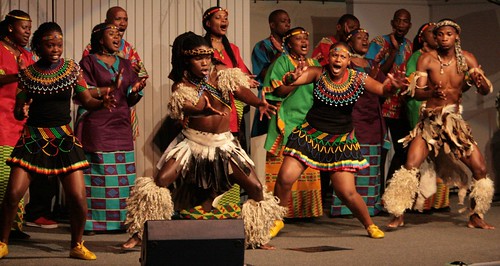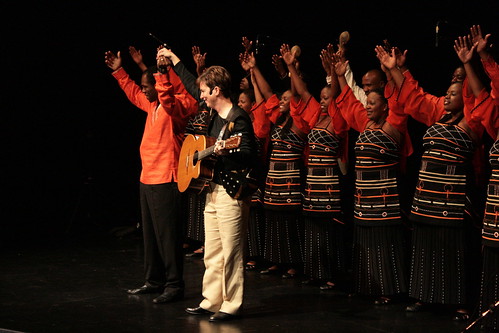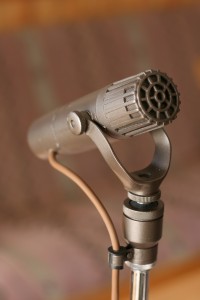Memeza Africa – 3rd Canadian Tour
A fantastic choir from South Africa is back once again for a coast-to-coast Canadian tour. I have had the pleasure of recording them, and traveling with them on tour as their bass player. Beautiful people and great singers and dancers!
They start off in Trail, BC on January 25, 2011, and hit numerous provinces, ending up in New Brunswick on February 25, 2011. Last time they were here was early 2009, and they were a big hit, with numerous sell-out shows and raving reviews. Their full schedule is on their website.
There are lots of pictures from the 2009 tour here.
Some pictures from the 2011 tour are here.
A Wired Article on Ribbon Mikes
This article just appeared in Wired. Here is a great quote: "We'll have bands come in and pick up that BK5 like it's coming out of the tomb of Tutankhamen," says Vanderslice, "Like it has this divine healing property. ..."
I have an RCA BK-5A ribbon mike in my studio and have used it on a number of things. Yeah, it sounds pretty good.
I guess I can now offer Divine Healing services! I better increase my rates!
Actually, Vanderslice continues: "... In the scheme of things, the content of the music, or the lyrics, or the sound of electric guitar or the amplifier, it is a very small percentage of what's going on."
Music?? Lyrics?? That stuff matters? Doh!! 😉
The Traditional Bluegrass Microphone Technique: Part 2
This article of mine appeared in the Northern Bluegrass Circle Music Society's December 2009 newsletter. Part 3 of of my two part article is now in the works!
----
The Traditional Bluegrass Microphone Technique. Part 2: How to Work the Mike
In Part 1, we discussed the basic characteristics of mikes. In this instalment, we talk about how to use a single mike. The single mike technique can work quite well, but it can also work really badly. The quality of the acoustic space, the mike and the sound system are important factors, and the sound person only has control of the overall tone and volume. Most of the success of the technique depends on the musicians' skill in working the mike.
Setup
The mike should be placed downstage (towards the audience) to minimize pick-up of echoes off the walls behind and to the sides of the mike. You may have to back it up a little if you get some feedback from the main speakers. Monitor wedges are occasionally used, but not very loud due to feedback. As we discussed in Part 1, proximity to the mike affects the loudness and tonal quality, so the mike needs to be set at the correct height for the band. Consider that the one mike has to pick up the vocals (mouth height) and the instruments (mostly belly height, except for fiddle), so take a look at the relative heights of everybody and their instruments and find a reasonable compromise that covers everything roughly equally. Since vocals are very important in bluegrass, the mike will be a little closer to the mouths than the instruments. The mike can be set a little lower than chin height as that will pick up a good blend of vocals and instruments, and will allow a good audience view of musicians' faces. About two-thirds of the way up, between the lowest instrument and the tallest singer's mouth is a good starting point, but you can experiment to find the best height. The mike will pick up sound from below your mouth, so you don't have to bend over into it. The mike picks up approximately a 120 degree zone on one side of the mike, so cluster your band in a tight arc on the pickup side of the mike.
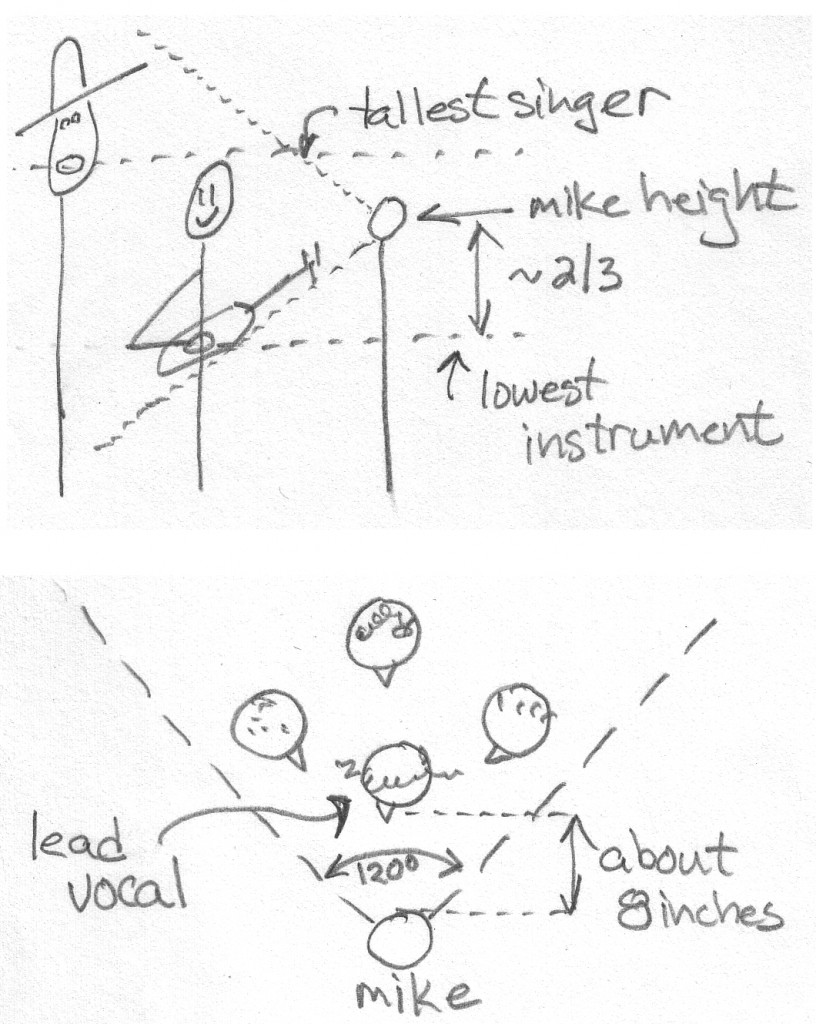
Fig. 1. Mike height and player placement.
Voices: Know Your Own Volume
There are louder singers, quieter singers, voices that project well, some that don't. Each singer's proximity to the mike will have to take that into account. The lead vocalist should generally be the closest and in the centre – 8 to 12 inches from the mike. Backup vocals should be off to the sides and a little further away, and louder singers will have to back off a little. Some people may have to lean in a little. If you have a quiet voice, get in closer, but not too close - six inches should be about the closest you ever get. During a quiet passage, you should get closer to make sure the words are intelligible. When you belt it out, you can back off a lot and still get the effect without knocking over the first few rows of the audience. Connect the dynamics of the song to the distance from the mike. During your band's vocal practice, it's a good idea to include mike technique practice.
Instruments: Know Your Own Volume
The same idea applies to the instruments. In general, instruments playing rhythm can be further away because they're providing a supporting role, and an instrumental break requires that the instrument be closer to the mike. Usually the acoustic guitar is the quietest instrument, but it depends on your playing style. You can make that Martin project pretty loud (ask your Bluegrass Workshop instructor how), but generally the guitar needs to be quite a lot closer than most instruments, and you may have noticed how the other players in bands usually quiet right down when the guitar takes a break. The main difficulty with the guitar is that getting in close can completely change the tone so it's good to know how different regions of the instrument sound different in front of a mike. If you put the sound hole right in front of the mike, it can sound too boomy with poor definition. Move the guitar over so that the 12th fret on the fingerboard is right in front, and the sound gets much tinnier. Somewhere in between should be optimal so experiment with your own guitar to find the best sounding mike-guitar orientation.
Mandolins generally pick up fairly well even at a distance and they cut through because of their tone. When players do the chop, they can be quite a ways back, but they do need to get a little closer to the mike for the breaks. The banjo is often the loudest instrument, so it can be further away (outside in the parking lot is good).
Due to its size, the standup bass usually ends up the furthest away, and often the bottom end of the instrument sounds fairly weak through the sound system. However if it gets closer, there may be too much string slap. Many top bluegrass bands (such as the Del McCoury Band) will compensate for this by plugging the bass into a separate channel using a direct input (DI) box (oops, did I say "plug-in" in a bluegrass newsletter??).
Side Mikes
You may have noticed a lot of bands use a side mike or two. The placement of one or two small hyper-cardioid (very directional) mikes can make playing instrumental breaks and incidental fills more convenient. These mikes can be placed at more appropriate heights for the instruments. Both Cherryholmes and The Steeldrivers made great use of side mikes at the Edmonton Folk Music Festival this past summer.
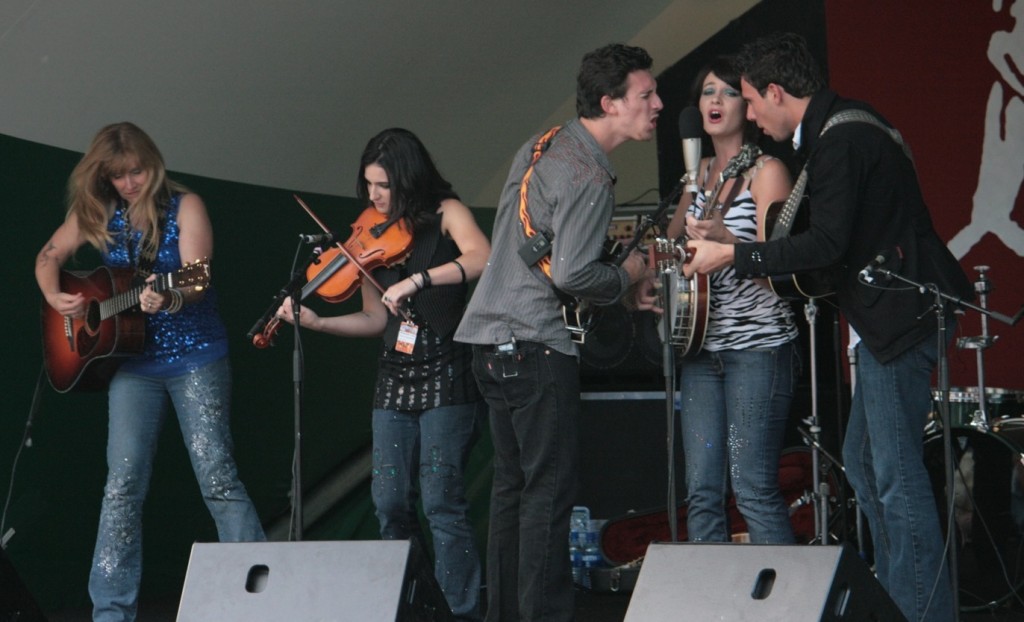
Fig. 2. Cherryholmes. Single mike (looks like a Shure KSM44) in the centre and two side mikes for instrumental breaks and fills. (Photo by Kevin Jacobson)
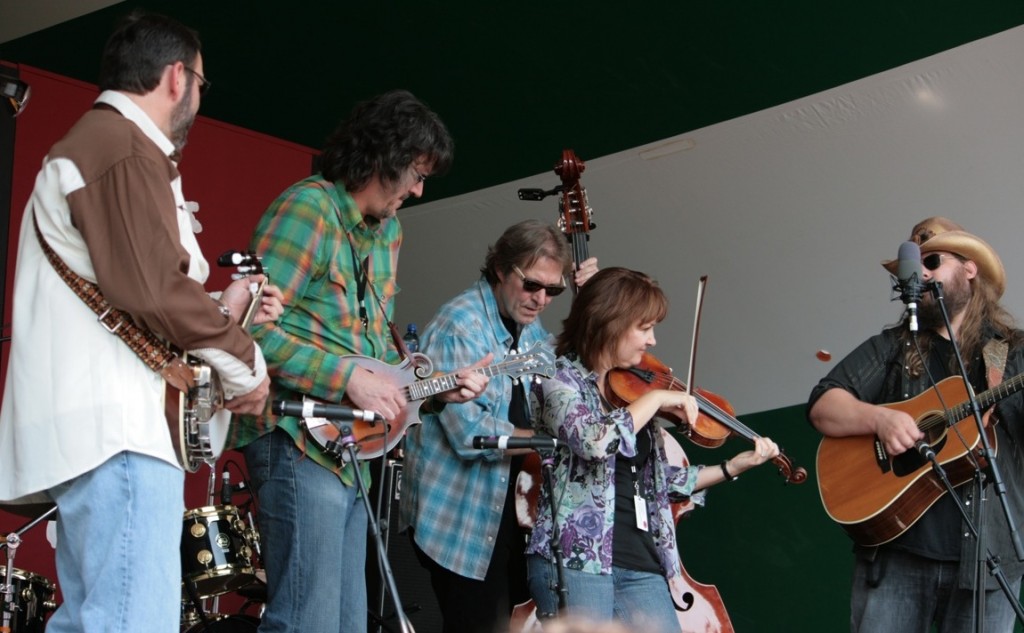
Fig. 3. The Steeldrivers. Single mike (far right, in front of guitar player's face). IMO, the mike was a bit too high - the fiddle player had to stand on tippy-toes to sing into it. Shure SM57s being used as side mikes. SM57s are cheap dynamic mikes, but surprisingly good. (Photo by Kevin Jacobson)
Practice and Experiment
Just like anything else, it's a great idea to practice mike technique with your band. If you can, set up a mike and a simple recording system at home and try it out. Try it by yourself, try it with your whole band. Try it vocals only, instruments only, and then all together. When you play somewhere, have someone in the audience listen carefully so they can provide some constructive advice. Search for Del McCoury videos on youtube and watch some pro-level microphone work. In particular, check out their performance of Nashville Cats in Austin (below) - a great example of mike technique. Watch how close they get for lead vocals, backing vocals, and instrumental fills and breaks.
Make a Show of It
The most important thing is to sound good, so at the very least your band needs to practice moving around the mike and each other to accommodate what's happening in the song. The lead vocalist needs to move aside for the instrumental breaks, instrumentalists and backup vocalists move in and out as needed. So practice this for every song you do. Once you get skilled, you can choreograph an interesting show with mike technique. Have people zip around the mike to new positions, shuffle people around. Fool around and have fun!
by Kevin Jacobson (www.cavemusic.ca)
Reggae Reading Room

Lately I've been reading a lot. Okay, I usually read a lot. More specifically, I've been reading a lot of books related to music. Right now I'm the working through The Rough Guide to Reggae by Steve Barrow and Peter Dalton. If you're into reggae or ska at all, it's a fantastic resource. It traces the development of reggae from mento, a Jamaican form of calypso, through dancehall, ska, rudeboy, rocksteady, reggae, dub, to the beats of today, and describes the influences from US-based R&B and soul. The book lists a huge (really huge - I'm not kidding) number of artists and producers that were key in the development of reggae. Of course everybody's heard of Bob Marley and the Wailers, but although they are one of the most important figures in the reggae world (and Aston Barrett is one of my most favouritest bass players ever), there's waaaay more to reggae than Bob.

Tons of recommended CDs and records are listed too, but many are kind of obscure. I discovered a website for Soul Jazz Records, which has a lot of Studio One material available on CD, LP and mp3, including many compilations. Studio One, run by Coxsone Dodd, was one of the most influential studios in Jamaica. They have a cool compilation series, the 100% Dynamite Series, which contains some good material throughout the development of reggae.
Some of the artists and bands I need to get more of: The Skatalites, Lee (Scratch) Perry, The Upsetters, The Maytals, The Abyssinians, Burning Spear, The Heptones, Alton Ellis, Slim Smith, Roland Alphonso, Augustus Pablo, U-Roy, I-Roy, Jackie Mittoo, Delroy Wilson, .... and I haven't even got half way through the book yet! And it's due back at the library in a few days! Oh yeah I think there's a companion CD you can get. I'll have to look into that.
Also included are some sidebar informational snippets on rastafarianism, and political and economic stuff that went on in Jamaica. These things are very much tied in with the music of Jamaica. Very interesting.
Side Note
Where did the word reggae come from? There seems to be a few theories on that. In The Rough Guide to Reggae, Steve Barrow says "Singer-producer Clancy Eccles, who has been credited with deriving the name 'reggae' from 'streggae' (Kingston street slang for a kind of good-time girl), ..." However, Barrow also says the first record to use the term was "Do the Reggay" by The Maytals (led by Toots Hibbert). And Hibbert says the word just "came out of my mouth" (see this article). Bob Marley claims that it came from a Spanish word meaning "the king's music". Whatever.
Making Basses!

Recently a great video feature appeared on Behind The Notes. A bass and guitar maker from NY talks about how he got into guitar making, and some of the construction and setup details on his instruments. He sounds like quite a knowledgeable guy. If you're interested in or play guitar or bass, you'll learn a bit about guitar construction, setup geometry, fret work, and more. Quite fascinating.
Sadwosky Feature
Roger Sadowsky's basses are becoming the "it" basses with a lot of players. He is a perfectionist when it comes to fret work and instrument setup, and his basses have been called "Fenders on steroids" as they are based on classic Fender Jazz and Precision designs, but with numerous improvements. What's interesting is that he has two lines of basses. A customizable line is made in New York, and naturally those are quite expensive. He also has a shop in Tokyo, Japan that makes instruments with essentially the same quality and attention to detail, but with fewer options than the NYC models (like the fancy tops), and offers them at a reduced price. They're pretty cool looking too!
Sadowsky's website
Memeza Africa is back home
After a very successful whirlwind tour, with numerous sellout shows, the choir is back home in South Africa. Hopefully we will see them here again.
Keep your eyes on their website for updates: Memeza Africa.
Check out photos of their May 3, 2008 concert at McDougall United Church in Edmonton:
slideshow here (photos by Tracy Kolenchuk).
Edit (2009.03.31): Please note they have a new website at www.memezaafrica.org
Memeza Africa is in Alberta
A bunch of great singers have arrived from Soweto, South Africa. The Memeza Africa choir will be performing all over Alberta during April and May. They sing some fantastic stuff, so you should check them out!!! Check their website for concert dates.
Here are a few of them:
Edit (2009.03.31): Please note they have a new website at www.memezaafrica.org
Muscle Shoals and the Rhythm Section
So anyway, here is an interesting thing. I was poking through my old vinyl record collection and pulled out a disc I picked up a long time ago ($4.99 at Madplatters - wherever that was) by the Muscle Shoals Horns called "doin' it to the bone." That reminded me of an article I had read, also along time ago, in Bass Player magazine - an interview with David Hood, the bass player for the Muscle Shoals Rhythm Section. I knew a bit about Muscle Shoals, because a lot of music came out of that little town in Alabama, with hits from artists like Percy Sledge, Etta James, Aretha Franklin (there's an interesting story why she only recorded a couple of tracks there - one of which was unfinished - and never returned), Wilson Pickett, Cher, Paul Simon, Boz Scaggs, Bob Seger and many more. It's also the birthplace of W.C. Handy and Hellen Keller. So there. Being that important in music history, I figured I should learn a bit more about Muscle Shoals, AL.

A small studio started by Rick Hall and partners called Fame Studios seems to be the genesis of the whole thing. They attracted early attention with a big hit by Percy Sledge - "When A Man Loves a Woman" - and later a bunch of musicians hanging around there garnered interest from Jerry Wexler of Atlantic Studios in New York. This bunch, which came to be known as the Muscle Shoals Rhythm Section (a.k.a. The Swampers) and consisting of David Hood, Roger Hawkins, Jimmy Johnson and Barry Beckett, decided to buy a studio housed in a former casket factory at 3614 Jackson Highway (now a museum) in nearby Sheffield. This group at this studio is responsible for recording, producing, and performing on an amazing number of big hits, covering a wide range of musical styles. They were inducted into the Alabama Music Hall of Fame in 1995 ("Non-Performing Achievement" ?? Whut?). That's just the bare outline to this whole story, so if you're interested finding out more (as I am), see below.
There's a book on the music emanating from the Muscle Shoals area called Music Fell on Alabama, by C.S. Fuqua. I hear it's pretty good, but it's not in any of my local libraries, so I haven't been able to read it yet. I think I may order a copy online.
Of course, there is also a lot of info on that internet-web thingy (and you can pretty much believe everything you read there). Here are a few links to get you started:
prosoundweb story
FAME Studios History
FAME Studios - Musician History
MSRS Bio
Muscle Shoals area attractions including the log cabin that was the birthplace of the father of the blues, and the original Muscle Shoals Sound Studios.
Or, you could just google it.
Anyhow, gotta get that vinyl spinning on the old Systemdek ....

